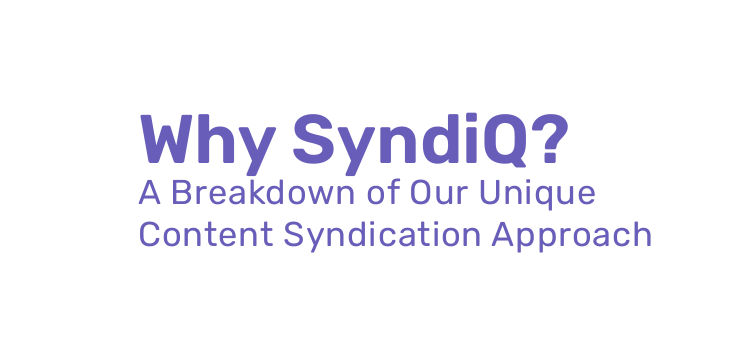In an era where data privacy regulations are tightening and third-party data is becoming less reliable, businesses are increasingly turning to first-party data as a valuable asset for marketing strategies. First-party data, which is collected directly from your audience through their interactions with your website, emails, or apps, is not only more reliable but also helps ensure compliance with privacy laws. One area where first-party data can make a significant impact is in content syndication, a strategy used to distribute content across various platforms to reach a broader audience.
In this blog, we’ll explore how businesses can effectively leverage first-party data to enhance their content syndication efforts, drive higher-quality leads, and improve overall marketing performance.
What is First-Party Data?
First-party data refers to information that is collected directly from your customers or prospects. This data is gathered from various touchpoints such as website visits, email interactions, CRM systems, social media engagements, and even customer surveys. Because it comes directly from your audience, first-party data is considered highly accurate and reliable. This type of data includes insights such as:
- User demographics
- Purchase behaviour
- Content preferences
- Engagement history
- Website navigation patterns
Unlike third-party data, which is bought from external sources and may not always be reliable or compliant with data privacy regulations, first-party data is owned by your business and can be used with greater confidence.
The Role of First-Party Data in Content Syndication
Content syndication involves distributing your content, such as blog posts, whitepapers, case studies, and videos, across third-party platforms to reach a larger audience. However, for content syndication to be truly effective, the content needs to be targeted to the right audience—this is where first-party data comes in.
By using first-party data, businesses can:
- Better Understand Their Audience: First-party data provides in-depth insights into the preferences, behaviors, and needs of your audience, allowing you to create and syndicate content that resonates with them.
- Improve Targeting and Personalization: With detailed information about your audience, you can tailor your content distribution to reach the right people, improving the chances of engagement and conversion.
- Optimize Content Performance: Tracking how your audience interacts with your content allows you to refine your content syndication strategy over time, focusing on the platforms and content types that drive the best results.
How to Leverage First-Party Data for Effective Content Syndication
1. Identify Your Target Audience
One of the key benefits of first-party data is that it helps you build a clear picture of your target audience. By analyzing data from your website, email campaigns, and CRM systems, you can segment your audience based on factors such as demographics, interests, and engagement history. These insights allow you to create highly targeted content syndication campaigns that speak directly to the needs and preferences of each audience segment.
For example, if you notice that a particular segment of your audience engages more with video content, you can prioritize video content in your syndication strategy for that segment.
2. Create Relevant and Personalized Content
First-party data provides insights into the types of content your audience is most interested in. Use this information to create content that addresses their pain points, answers their questions, and offers solutions to their problems. Personalized content is more likely to resonate with your audience and drive higher engagement.
Additionally, using first-party data allows you to tailor the content you distribute through syndication channels. Instead of using a one-size-fits-all approach, you can create customized content for different audience segments based on their preferences, ensuring that your content syndication efforts are more effective.
3. Choose the Right Syndication Platforms
Not all syndication platforms will be equally effective for every business. First-party data helps you determine which platforms are most likely to reach your target audience. By analyzing how your audience engages with your content across various touchpoints, you can identify the platforms that are best suited for syndicating your content.
For instance, if your first-party data indicates that a significant portion of your audience consumes content through industry-specific blogs or professional forums, you can focus your syndication efforts on these channels.
4. Enhance Lead Generation and Scoring
First-party data can be used to improve lead generation efforts through content syndication by identifying which prospects are most likely to convert. By tracking how leads interact with syndicated content, you can develop a lead scoring system that assigns points based on engagement levels. This system helps you prioritize the leads that are most ready for sales outreach.
For example, if a lead downloads multiple whitepapers and engages with several pieces of syndicated content, your lead scoring system can mark them as highly engaged and ready for follow-up. This helps your sales team focus on the most promising leads, increasing the chances of conversion.
5. Track and Measure Engagement
First-party data allows you to track how your audience interacts with your content across various syndication platforms. By measuring key metrics such as time spent on content, click-through rates, and conversion rates, you can gain insights into what works and what doesn’t. Use this data to refine your content syndication strategy over time, ensuring that you’re consistently delivering value to your audience.
Tracking engagement across platforms also allows you to optimize your content formats. If you find that certain types of content (e.g., infographics, case studies, or video tutorials) perform better on specific platforms, you can adjust your strategy to focus on those formats.
Benefits of Leveraging First-Party Data for Content Syndication
1. Improved Audience Targeting
First-party data allows for more accurate audience targeting. By understanding who your audience is and what they care about, you can tailor your content syndication efforts to deliver content that resonates with them. This leads to higher engagement and better overall campaign performance.
2. Better Compliance with Privacy Regulations
As data privacy regulations become more stringent, relying on first-party data ensures that you remain compliant. Unlike third-party data, first-party data is collected directly from your audience with their consent, reducing the risk of privacy violations and enhancing trust with your customers.
3. Increased Engagement and Conversions
Content syndication backed by first-party data is more likely to result in meaningful interactions. By delivering personalized, relevant content to the right audience, businesses can increase engagement rates and drive higher conversions.
4. Maximized ROI
With first-party data informing your content syndication strategy, you’re more likely to see a higher return on investment (ROI). By focusing your efforts on the platforms and content types that drive the best results, you can allocate your resources more efficiently and achieve better outcomes.
Conclusion
First-party data is a powerful tool that can significantly enhance the effectiveness of content syndication. By using this data to better understand your audience, create personalized content, and improve targeting, businesses can drive higher-quality leads, increase engagement, and improve their overall marketing performance. As third-party data becomes less reliable and privacy regulations tighten, leveraging first-party data will be key to staying ahead in the ever-evolving world of B2B marketing.




